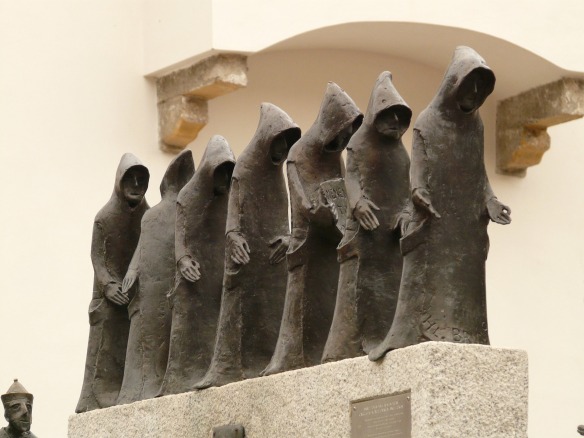
While the DIY retreat was (to some extent) about unplugging, there are a lot of opportunities for spiritual growth online. Here are just a few of my favorites:
Blogs
Blogs were sort of my entry point to digital spirituality (it was about the time I started Episcotheque that I really became interested), and while I don’t have as much time to read them anymore as I would like, they’re still a great resource. I have so many more favorites than just the ones I’ve named, but this is a start.
Rachel Held Evans
I feel like I can safely assume you’ve heard of Rachel Held Evans, but I figured she still had to make the list.
Jamie the Very Worst Missionary
Jamie doesn’t seem to be posting that much anymore (like I have any room to talk), but I always enjoy what she has to say and how she says it.
Christianity Today Women (previously her.meneutics)
A little on the evangelical side of things for my taste much of the time, but I really enjoy the variety of posts and can always find some food for thought.
Storyline
Donald Miller’s swung a bit far into the business world for me to keep up, but the Storyline blog still has some great content.
Websites
Non-blog websites also offer interesting and useful resources.
3-Minute Retreat
This is a fantastic website (also available as an app, but I prefer the large format of a computer screen) run by Loyola Press that provides short guided meditations with music, scripture, and reflections.
EXAMEN.me
An Ignatian spirituality resource that allows you to create an account and save journal entries that you create as part of their Examen process. While I haven’t used it much, it’s a neat idea.
Apps
There are a number of good apps out there for spiritual growth as well, though some I list here are specifically tied to religion. My links are largely to iOS versions, because I have Apple products, so apologies if that is inconvenient for you non-iPhone users.
Reimagining the Examen
This is another resource out of Loyola Press (they’re doing some great work!) that I like for its simplicity and applicability. It’s an easy-to-follow, aesthetically pleasing, updated Examen. I actually found another Examen Prayer app while I was searching for the url for this one, and it also looks promising, but I can’t personally recommend it as I haven’t tried it out yet.
Mission St. Clare
This is also a website, but in this case I prefer the app. Mission St. Clare has been offering an online daily office since 1995(!), and while the aesthetics of this app leave something to be desired, the functionality is great if you want an easy way to pray the 1979 BCP daily office on the go.
Meditation Apps
There are loads of meditation apps out there, and I think the key is finding one that works for you. Headspace and Stop, Breathe, Think are both subscription-based, which I’m not a huge fan of, but both offer free introductory content of some sort. While not specifically religious, the quality-of-life improvement that meditation can bring is definitely tied to spiritual wellbeing.
Journaling Apps
I would also include journaling apps as non-religious but helpful to spiritual growth. My favorite is Day One—one of many neat features is the ability to have multiple journals (and/or tag entries in the same journal), so if you want to write about a particular topic in your spiritual life or track your thoughts on something over a period of time, you can do that.
__________
Do you have a favorite blog, website, or app that benefits your spiritual life? What is it?







 This language makes total sense to me, because I have seen firsthand that good, interesting, useful work can come out of people doing work that excites and energizes them, and cultivating awareness around that can, I think, lead to an exciting and energizing life.
This language makes total sense to me, because I have seen firsthand that good, interesting, useful work can come out of people doing work that excites and energizes them, and cultivating awareness around that can, I think, lead to an exciting and energizing life. It’s (one of) the most wonderful time(s) of the year: fall. The leaves are turning, the nights are getting cooler, and even though I’m in the middle of Manhattan, I can imagine myself at a bonfire or—one of my personal favorites—at an apple orchard.
It’s (one of) the most wonderful time(s) of the year: fall. The leaves are turning, the nights are getting cooler, and even though I’m in the middle of Manhattan, I can imagine myself at a bonfire or—one of my personal favorites—at an apple orchard. A good portion of my seminary coursework has been in the area of spiritual direction. I’ve enjoyed the opportunity to take practicum classes amid more heady intellectual work, and I really enjoy having the chance to talk with people about God and their experience of God. A common question in spiritual direction is, “How have you been praying about this?” Sometimes this is an easy question to answer, but often it isn’t. In fact, I’ve talked to plenty of people who just aren’t that keen on prayer.
A good portion of my seminary coursework has been in the area of spiritual direction. I’ve enjoyed the opportunity to take practicum classes amid more heady intellectual work, and I really enjoy having the chance to talk with people about God and their experience of God. A common question in spiritual direction is, “How have you been praying about this?” Sometimes this is an easy question to answer, but often it isn’t. In fact, I’ve talked to plenty of people who just aren’t that keen on prayer. Mandalas
Mandalas Walking/Labyrinths
Walking/Labyrinths